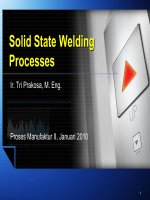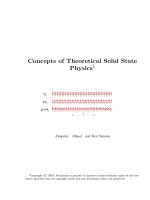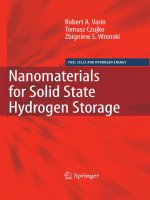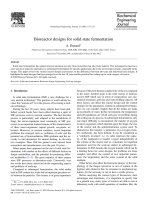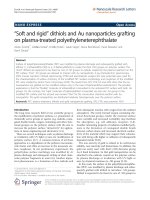Bab 28 solid state welding (1)
Bạn đang xem bản rút gọn của tài liệu. Xem và tải ngay bản đầy đủ của tài liệu tại đây (1.79 MB, 103 trang )
Solid State Welding
Solid State Welding
Processes
Processes
Ir. Tri Prakosa, M. Eng.
Proses Manufaktur II, Januari 2010
1
INTRODUCTION
INTRODUCTION
Institut Teknologi Bandung2
Introduction
Introduction
This lecture describes processes in which joining takes place without fusion (melting) of the workpieces.
Unlike the processes described in previous lecture, no liquid (molten) phase is present in the joint.
The principle of solid-state welding is best demonstrated with the following example.
Institut Teknologi Bandung3
Introduction
Introduction
If two clean surfaces are brought into atomic contact with each other under sufficient pressure and in the absence of oxide films and
other contaminants they form bonds and produce a strong joint.
Heat and some movement of the mating surfaces by plastic deformation may be employed to improve the strength of the joint.
Institut Teknologi Bandung4
Introduction
Introduction
Applying external heat improves the bond by diffusion.
Small interfacial movements on the faying surfaces (contacting surfaces of the two pieces to be joined) disturb the surfaces, breaking up
oxide films and generating new and clean surfaces, thus improving the strength of the bond.
Heat may also be generated by friction, which is utilized in friction welding.
Institut Teknologi Bandung5
Introduction
Introduction
Electric-resistance heating is utilized extensively in resistance welding processes with numerous applications.
In explosion welding, very high contact pressures are developed, causing welding of the interface.
Institut Teknologi Bandung6
Introduction
Introduction
This lecture concludes coverage of welding processes.
The topics of the metallurgy of welding, welding design, weld quality, and welding process selection are described next week.
Other joining processes such as brazing, soldering, adhesive bonding and mechanical fastening methods are covered in the next two
weeks.
Institut Teknologi Bandung7
COLD WELDING (CW)
COLD WELDING (CW)
Institut Teknologi Bandung8
Cold Welding (CW)
Cold Welding (CW)
In cold welding (CW), pressure is applied to the workpieces, either through dies or rolls.
Because of the plastic deformation involved, it is necessary that at least one, but preferably both, of the mating parts be ductile.
The interface is usually cleaned by wire brushing prior to welding.
Institut Teknologi Bandung9
Cold Welding (CW)
Cold Welding (CW)
However, in joining two dissimilar metals that are mutually soluble, brittle intermetallic compounds may form, resulting in a weak and
brittle joint.
An example is the bonding of aluminum and steel, where a brittle intermetallic compound is formed at the interface.
The best bond strength and ductility is obtained with two similar materials.
Institut Teknologi Bandung10
Cold Welding (CW)
Cold Welding (CW)
Cold welding can be used to join small workpieces made of soft, ductile metals.
Applications include electrical connections and welding wire stock.
Institut Teknologi Bandung11
Roll bonding
Roll bonding
The pressure required for cold welding can be applied through a pair of rolls. Hence the process is called roll bonding.
Institut Teknologi Bandung12
Ilustrasi skematik proses roll
bonding, atau cladding.
Roll bonding
Roll bonding
Developed in the 1960s, roll bonding is used for manufacturing certain U.S. coins.
The process can be carried out at elevated temperatures (hot roll bonding).
Typical examples are cladding pure aluminum over aluminum-alloy sheet and stainless steel over mild steel for corrosion resistance.
Institut Teknologi Bandung13
ULTRASONIC WELDING
ULTRASONIC WELDING
Institut Teknologi Bandung14
Ultrasonic Welding (USW)
Ultrasonic Welding (USW)
In ultrasonic welding (USW), the faying surfaces of the two members are subjected to a static normal force and oscillating shearing
(tangential) stresses.
The shearing stresses are applied by the tip of a transducer (the following Figure-a), similar to that used for ultrasonic machining.
The frequency of oscillation generally ranges from 10 kHz to 75 kHz, although both lower and higher frequencies than these can be
employed.
Institut Teknologi Bandung15
Ultrasonic Welding
Ultrasonic Welding
Institut Teknologi Bandung16
(a) Komponen mesin las
ultrasonik untuk
pengelasan lap.
Getaran lateral
ujung peralatan
menyebabkan
deformasi plastis dan
ikatan pada antar
muka bendakerja.
Ultrasonic Welding (USW)
Ultrasonic Welding (USW)
The energy required increases with the thickness and hardness of the materials being joined.
Proper coupling between the transducer and the tip (called sonotrode, from the word sonu, as contrasted to electrode) is important for
efficient operation.
Institut Teknologi Bandung17
Ultrasonic Welding (USW)
Ultrasonic Welding (USW)
The shearing stresses cause plastic deformation at the workpiece interfaces, breaking up oxide films and contaminants and thus
allowing good contact and producing a strong solid-state bond.
Temperatures generated in the weld zone are usually in the range of one-third to one-half the melting point (absolute scale) of the
metals joined.
Therefore no melting and fusion take place.
Institut Teknologi Bandung18
Ultrasonic Welding (USW)
Ultrasonic Welding (USW)
In certain situations, however, temperatures can be sufficiently high to cause metallurgical changes in the weld zone.
The mechanism of joining plastics by ultrasonic welding is different from that for metals, and melting takes place at the interface,
because of their much lower melting temperatures.
Institut Teknologi Bandung19
Ultrasonic Welding (USW)
Ultrasonic Welding (USW)
The ultrasonic welding process is reliable and versatile. It can be used with a wide variety of metallic and nonmetallic materials,
including dissimilar metals (bimetallic strips).
It is used extensively in joining plastics and in the automotive and consumer electronics industries for lap welding of sheet, foil, and thin
wire and in packaging with foils.
Institut Teknologi Bandung20
Ultrasonic Welding (USW)
Ultrasonic Welding (USW)
The welding tip can be replaced with rotating disks (Figure b) for seam welding structures,
Moderate skill is required to operate the equipment.
Institut Teknologi Bandung21
(b) Pengelasan
sambungan ultrasonik
menggunakan roller.
FRICTION WELDING
FRICTION WELDING
Institut Teknologi Bandung22
Friction Welding (FRW)
Friction Welding (FRW)
In the joining processes that have been described so far, the energy required for welding such as chemical, electrical, and ultrasonic, is
supplied externally.
In friction welding (FRW), the required heat for welding is, as the name implies, generated through friction at the interface of the two
members being joined.
Thus the source of energy is mechanical.
Institut Teknologi Bandung23
Friction Welding (FRW)
Friction Welding (FRW)
It can be demonstrated the significant rise in temperature from friction by rubbing our hands together fast or sliding down a rope rapidly.
In friction welding, one of the members remains stationary while the other is placed in a chuck or collet and rotated at a high constant
speed.
The two members to be joined are then brought into contact under an axial force (next Figure).
Institut Teknologi Bandung24
Friction Welding (FRW)
Friction Welding (FRW)
Institut Teknologi Bandung25
Urutan operasi pada proses pengelasan gesekan:
1. Komponen sebelah kiri diputar pada kecepatan tinggi.
2. Komponen sebelah kanan didekatkan dan diberi gaya aksial.
3. Gaya aksial ditingkatkan; flash mulai terbentuk.
4. Komponen sebelah kiri dihentikan putarannya; pengelasan selesai.
Selanjutnya flash dapat dihilangkan dengan pemesinan atau gerinda.
